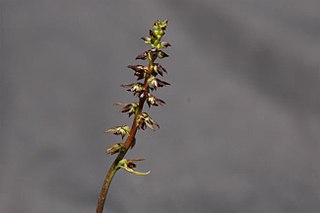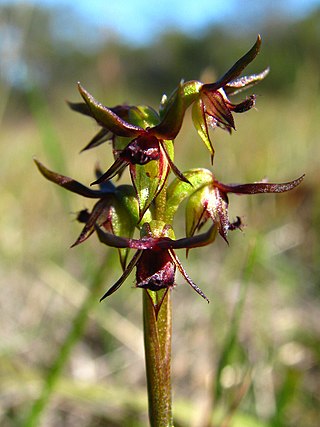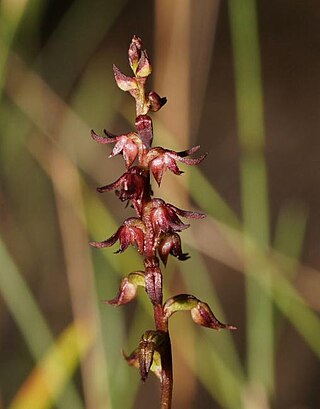
Genoplesium plumosum, commonly known as the Tallong midge-orchid or plumed midge-orchid, is a species of orchid endemic to New South Wales. It is a small orchid only known from a few sites near the towns of Tallong and Wingello on the Southern Tablelands and is only relatively easy to find for about a month, when it flowers. It has been classified as "Endangered" under the EPBC Act.
Genoplesium woollsii, commonly known as the dark midge-orchid, is a species of orchid endemic to New South Wales. It has a single thin, wiry leaf and in autumn has up to thirty five drooping, dark purple flowers on a flowering stem which is fused to the lower part of the leaf.
Genoplesium rufum, commonly known as the rufous midge-orchid, is a species of orchid endemic to New South Wales. It has a single thin, wiry leaf and up to twenty five drooping, pinkish or reddish flowers on a flowering stem which is fused to the lower part of the leaf. It was formerly thought to range from Queensland to South Australia and Tasmania but specimens in other states are now assigned to Genoplesium clivicola.

Genoplesium morrisii, commonly known as the bearded midge orchid and known as Corunastylis morrisii in Australia, is a small terrestrial orchid endemic to south-eastern Australia. It has a single thin leaf fused to the flowering stem and up to fifteen small, dark purplish-black or green and purple flowers.
Corunastylis nigricans, commonly known as the Kangaroo Island midge orchid is a small terrestrial orchid endemic to South Australia. It has a single thin leaf and up to twenty five purplish brown flowers with a shiny, hairless, dark purplish labellum. It is sometimes confused with Genoplesium nigricans which has differently coloured flowers and a much wider distribution. It is regarded as a synonym of G. nigricans by the World Checklist of Selected Plant Families.

Genoplesium archeri, commonly known as the elfin midge orchid and as Corunastylis archeri in Australia, is a small terrestrial orchid endemic to south-eastern Australia. It has a single thin leaf fused to the flowering stem and up to fifteen small, hairy, yellowish green flowers with purple stripes. It grows in a wide range of habitats in New South Wales, Victoria and Tasmania.
Genoplesium littorale, commonly known as the Tuncurry midge orchid, is a species of small terrestrial orchid endemic that is endemic to New South Wales. It has a single thin leaf fused to the flowering stem and up to thirty small green flowers with a purple-brown labellum. It is only known from fewer than two thousand plants in a small area on the New South Wales North Coast and is critically endangered.
Genoplesium bishopii, commonly known as the Gibraltar Range midge orchid, is a small terrestrial orchid endemic to New South Wales. It has a single thin leaf fused to the flowering stem and up to thirty small, dark purplish red flowers. It grows in heathy forest and on the edges of swamps in the Gibraltar Range National Park.
Genoplesium brachystachyum, commonly known as the Rocky Cape midge orchid or short-spike midge orchid, is a species of small terrestrial orchid endemic to Tasmania. It has a single thin leaf fused to the flowering stem and up to twelve small, green to brownish green, and reddish flowers. It usually grows in heath in rocky places near the coast.
Genoplesium eriochilum, commonly known as the Mount Wilson midge orchid, is a species of small terrestrial orchid endemic to the Blue Mountains. It has a single thin leaf fused to the flowering stem and up to twenty small, crowded, dark purplish brown flowers. It usually grows between low shrubs and sedges.
Genoplesium firthii, commonly known as Firth's midge orchid, is a species of small terrestrial orchid endemic to Tasmania. It has a single thin leaf fused to the flowering stem and up to six small, yellowish green or reddish flowers with a red labellum. It grows in coastal heath and scrub and is currently only known from a single population of about twelve plants near Coles Bay.
Genoplesium parvicallum, commonly known as the mountain-top midge-orchid, is a species of orchid which is endemic to Queensland. It is a small orchid with up to twenty five greenish flowers with purplish brown marking and is only known from mountaintops in the McPherson Range. It is treated as Corunastylis parvicalla in Queensland.

Genoplesium pumilum, commonly known as the green midge orchid in Australia, and the yellow gumland leek orchid in New Zealand is a small terrestrial orchid native to south-eastern Australia and New Zealand. It has a single thin leaf fused to the flowering stem and up to twenty five green to yellowish-green flowers which sometimes have red markings. Australian and New Zealand authorities use the name Corunastylis pumila.

Genoplesium rhyoliticum, commonly known as the Pambula midge-orchid or rhyolite midge orchid and as Corunastylis rhyolitica in Australia, is a species of orchid endemic to New South Wales. It is a small orchid with up to eighteen dark, purplish-black flowers and is only known from six sites on the south coast where it grows in shallow soil over rhyolite.

Genoplesium ruppii, commonly known as Rupp's midge orchid, is a species of small terrestrial orchid that is endemic to eastern Australia. It has a single thin leaf fused to the flowering stem and up to twenty five small, hairy green flowers with a purple labellum.
Genoplesium sagittiferum, commonly known as the horned midge orchid, is a species of small terrestrial orchid that is endemic to New South Wales. It has a single thin leaf fused to the flowering stem and up to ten small, yellowish-green flowers with a hairy reddish labellum.
Genoplesium turfosum, commonly known as the alpine midge orchid, is a small terrestrial orchid endemic to a small area in the higher parts of New South Wales. It has a single thin leaf fused to the flowering stem and up to twenty five dark purplish-red, crowded flowers with a sparsely hairy labellum.
Genoplesium validum, commonly known as the Blackdown midge orchid, is a species of small terrestrial orchid that is endemic to the Blackdown Tableland National Park in Queensland. It has a single thin leaf fused to the flowering stem and up to thirty five greenish-brown flowers with reddish stripes and a hairy labellum. This species is treated as Corunastylis valida in Queensland.
Corunastylis densa, commonly known as the dense midge orchid, is a small terrestrial orchid endemic to eastern Australia. It has a single thin leaf fused to the flowering stem and up to twenty five densely crowded reddish-brown to dark purplish-brown flowers. It is found between the New England National Park and the Moroka River.

Genoplesium laminatum, commonly known as the red midge orchid, is a small terrestrial orchid endemic to New South Wales. It has a single thin leaf fused to the flowering stem and up to twenty bright reddish flowers. It grows in heath and grassy forest in a few places on the South Coast and Central Tablelands.






